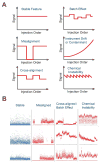Visualization, Quantification, and Alignment of Spectral Drift in Population Scale Untargeted Metabolomics Data
- PMID: 28208263
- PMCID: PMC5455767
- DOI: 10.1021/acs.analchem.6b04337
Visualization, Quantification, and Alignment of Spectral Drift in Population Scale Untargeted Metabolomics Data
Abstract
Untargeted liquid-chromatography-mass spectrometry (LC-MS)-based metabolomics analysis of human biospecimens has become among the most promising strategies for probing the underpinnings of human health and disease. Analysis of spectral data across population scale cohorts, however, is precluded by day-to-day nonlinear signal drifts in LC retention time or batch effects that complicate comparison of thousands of untargeted peaks. To date, there exists no efficient means of visualization and quantitative assessment of signal drift, correction of drift when present, and automated filtering of unstable spectral features, particularly across thousands of data files in population scale experiments. Herein, we report the development of a set of R-based scripts that allow for pre- and postprocessing of raw LC-MS data. These methods can be integrated with existing data analysis workflows by providing initial preprocessing bulk nonlinear retention time correction at the raw data level. Further, this approach provides postprocessing visualization and quantification of peak alignment accuracy, as well as peak-reliability-based parsing of processed data through hierarchical clustering of signal profiles. In a metabolomics data set derived from ∼3000 human plasma samples, we find that application of our alignment tools resulted in substantial improvement in peak alignment accuracy, automated data filtering, and ultimately statistical power for detection of metabolite correlates of clinical measures. These tools will enable metabolomics studies of population scale cohorts.
Conflict of interest statement
The authors declare no competing financial interest.
This set of annotated R-based scripts is available for the metabolomics community at
Figures



Similar articles
-
Comparison of peak-picking workflows for untargeted liquid chromatography/high-resolution mass spectrometry metabolomics data analysis.Rapid Commun Mass Spectrom. 2015 Jan 15;29(1):119-27. doi: 10.1002/rcm.7094. Rapid Commun Mass Spectrom. 2015. PMID: 25462372
-
Large-scale untargeted LC-MS metabolomics data correction using between-batch feature alignment and cluster-based within-batch signal intensity drift correction.Metabolomics. 2016;12(11):173. doi: 10.1007/s11306-016-1124-4. Epub 2016 Sep 22. Metabolomics. 2016. PMID: 27746707 Free PMC article.
-
Translational Metabolomics of Head Injury: Exploring Dysfunctional Cerebral Metabolism with Ex Vivo NMR Spectroscopy-Based Metabolite Quantification.In: Kobeissy FH, editor. Brain Neurotrauma: Molecular, Neuropsychological, and Rehabilitation Aspects. Boca Raton (FL): CRC Press/Taylor & Francis; 2015. Chapter 25. In: Kobeissy FH, editor. Brain Neurotrauma: Molecular, Neuropsychological, and Rehabilitation Aspects. Boca Raton (FL): CRC Press/Taylor & Francis; 2015. Chapter 25. PMID: 26269925 Free Books & Documents. Review.
-
IP4M: an integrated platform for mass spectrometry-based metabolomics data mining.BMC Bioinformatics. 2020 Oct 7;21(1):444. doi: 10.1186/s12859-020-03786-x. BMC Bioinformatics. 2020. PMID: 33028191 Free PMC article.
-
Advancing untargeted metabolomics using data-independent acquisition mass spectrometry technology.Anal Bioanal Chem. 2019 Jul;411(19):4349-4357. doi: 10.1007/s00216-019-01709-1. Epub 2019 Mar 7. Anal Bioanal Chem. 2019. PMID: 30847570 Review.
Cited by
-
Quantitative Comparison of Statistical Methods for Analyzing Human Metabolomics Data.Metabolites. 2022 Jun 4;12(6):519. doi: 10.3390/metabo12060519. Metabolites. 2022. PMID: 35736452 Free PMC article.
-
A Metabolomics Workflow for Analyzing Complex Biological Samples Using a Combined Method of Untargeted and Target-List Based Approaches.Metabolites. 2020 Aug 25;10(9):342. doi: 10.3390/metabo10090342. Metabolites. 2020. PMID: 32854199 Free PMC article.
-
[Alignment method for metabolite chromatographic peaks using an N-acyl glycine retention index system].Se Pu. 2024 Feb;42(2):159-163. doi: 10.3724/SP.J.1123.2023.07015. Se Pu. 2024. PMID: 38374596 Free PMC article. Chinese.
-
Cardiovascular Metabolomics.Circ Res. 2018 Apr 27;122(9):1238-1258. doi: 10.1161/CIRCRESAHA.117.311002. Circ Res. 2018. PMID: 29700070 Free PMC article. Review.
-
New frontiers for mass spectrometry based upon structures for lossless ion manipulations.Analyst. 2017 Mar 27;142(7):1010-1021. doi: 10.1039/c7an00031f. Analyst. 2017. PMID: 28262893 Free PMC article.
References
-
- Nicholson JK, Holmes E, Kinross JM, Darzi AW, Takats Z, Lindon JC. Nature. 2012;491:384–392. - PubMed
Publication types
MeSH terms
Grants and funding
LinkOut - more resources
Full Text Sources
Other Literature Sources

